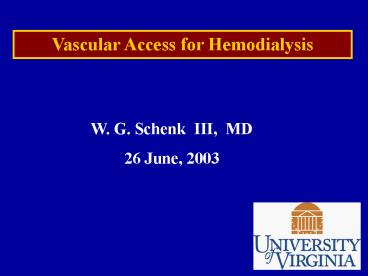Vascular Access for Hemodialysis PowerPoint PPT Presentation
1 / 43
Title: Vascular Access for Hemodialysis
1
Vascular Access for Hemodialysis
W. G. Schenk III, MD 26 June, 2003
2
(No Transcript)
3
Vascular Access for Hemodialysis
- LEARNING OBJECTIVES
- Understand the K-DOQI Guidelines that pertain to
vascular access, and their implications. - Develop a systematic approach to selection of a
specific vascular access option, including the
value of pre-op ultrasound. - 3. Incorporate into practice strategies for
avoiding complications of central venous access.
4
K-DOQI GUIDELINES 2000
DOQI National Kidney Foundation
- 140 specific clinical guidelines and benchmarks
- 38 apply to Vascular Access Issues
5
(No Transcript)
6
K-DOQI GUIDELINES 2000
Guideline III - 3
- Order of preference for permanent vascular
access - 1. Wrist fistula
- 2. Elbow fistula
- 3. PTFE graft OR 4. Basilic vein
transposition - 5. Permanent central lines should be
discouraged
7
K-DOQI GUIDELINES 2000
Guideline III - 29
Incidence / Prevalence of Primary AVF Primary
AVF should be constructed in at least 50 of
all new HD patients. Ultimate prevalence of AVF
gt 40 (2000) (implies gt20 primary
failure rate)
8
K-DOQI GUIDELINES 2000
Guideline III 36, 37
Primary Failure rate AVF No guideline is
recommended Cumulative patency of AV
Grafts 1 yr 70 2 yr 60 3 yr 50
9
K-DOQI GUIDELINES 2000
Guideline III - 30
Prevalence of Permanent Central
Lines Permanent (gt90 d) CL lt 10
10
Guidelines for Establishment of Dialysis Access
I. Peritoneal vs. Hemodialysis
- The primary factor is patient choice
education. - Contraindications to PD
- A. Multiple prior abdominal surgery
- B. Hernia (groin, umbilical, incisional)
- C. Adhesions
- D. Morbid Obesity
- E. Prior Failed Attempts
11
Guidelines for Establishment of Dialysis Access
II. Timing of Initiation
- Is there sufficient time to avoid interim
access. - Based upon
- A. Chemistries
- B. Volume status
- C. Uremic and other symptoms
- D. Rate of Change
- Allow 6-8 wks to establish permanent hemo access
12
Guidelines for Establishment of Dialysis Access
III. Priorities for Permanent Hemo Access
- Basic Principles
- A. Autologous before prosthetic
- B. Non-dominant side first
- C. Distal before proximal
- D. Pre-op assessment of practical success
- E. Preserve future options
- These priorities often conflict with each other
13
Guidelines for Establishment of Dialysis Access
III. Specific Recommendations \ Exclusion
Criteria for
- A. Wrist Fistula
- B. Elbow Fistula
- C. Basilic Vein Transposition
- D. PTFE anatomical Options
14
(No Transcript)
15
(No Transcript)
16
SPECIFIC CRITERIA
Radio-cephalic (Cimino) Fistula
Visible vein entire forearm The hypothetical
14 g. IV Adequate diameter gt 2.5 mm no focal
prob Radial A. gt 2.5 mm, not heavily
calcified Dominant side frequently used Normal
Allen Test occ. Hand/digit PVRs
17
(No Transcript)
18
(No Transcript)
19
Variations in Antecubital Venous Anatomy
Cephalic V Fistula would preclude future forearm
graft
Forearm Graft possible after properly constructed
fistula
20
SPECIFIC CRITERIA
Brachio-cephalic (elbow) Fistula
Visible vein is good but not critical Adequate
diameter min ID 3.5 mm Depth of vein lt 5-7
mm Adequate length, bottom Well-developed
superficial fascia -- problem Transposition not
very useful Trouble spot delto-pectoral groove
21
Upper Arm Fistula Anatomy
From Vascular Access, Wilson SA, 2002
The Basilic Vein Transposition behaves more like
a graft than a fistula
22
Basilic Vein Anatomy
BrachialVein
Basilic Vein
23
Basilic Vein Anatomy
Brachial Vein
Perforators
Basilic Vein
24
(No Transcript)
25
Anatomy of Basilic V. By Ultrasound Mapping
Basilic V.
5.5 mm
Cephalic V.
6.0 mm
4.0 mm
3.1 mm
Perf Branch
(Brach. A 4.1 mm)
26
SPECIFIC CRITERIA
Basilic Vein Transposition
Adequate length top Adequate length
bottom Adequate diameter min ID 4.5 mm Normal
arterial anatomy Inadequate overall length
practical failure
27
2 cm Above Antecubital Crease
28
Anomalous Origin of Radial Artery
Radial A.
Brachial A.
29
Radial A. 4.7 mm Brachial A. 3.8 mm
30
SUMMARY Adequate (Minimum) size Guidelines For
Venous Conduits
I.D. Determined by
Forearm (Cimino) Fistula 2.5 mm P.E. Above-Elbow
Fistula 3.5 mm PE/US Basilic Vein
Transposition 4.5 mm U/S
31
Loop Forearm Graft, Venous Preparation
32
SPECIFIC CRITERIA
PTFE A-V Graft
Autologous options have been considered /
excluded / exhausted (Exception graft first may
preserve future options) Absence of Collagen
Vascular Disease (Lupus Nephritis) Generally,
forearm before upper arm (Exception secondary
upper arm graft on non-dominant side) Superficial
vein target preferable to deep vein Min diam of
venous target gt4.5 mm, min length gt 16 mm Success
upper arm graft limited if diam lt 5 mm Arterial
target diam gt 3.5 mm (4.0 mm upper arm) Consider
5 mm graft Consider crossing joint
33
Bilateral Total Subclavian Vein Occlusion
34
STRATEGIES FOR AVOIDING COMPLICATIONS OF CENTRAL
VENOUS DIALYSIS ACCESS
Prediction of Dialysis Dependency Avoid
Subclavian Use IJ Insertion Techniques - Use
of Ultrasound Low-dose Coumadin (?) Role of
A-V Access Surveillance Anticipate need for
Surgical Revision Plan revision that permits
immediate use Timely Resuscitation of Graft
Thrombosis Consider Banked Graft
35
Intra-Operative Ultrasound
36
VALUE OF ULTRASOUND FOR SURGICALLY-INSTALLED
CENTRAL LINES
Preliminary Diagnostic Evaluation Patency,
Course, Continuity, Valves Adequate size (eg.,
18 F requires 7 mm.) Relationship to adjacent
structures Degree of Trendelenburg necessary
Puncture under real-time Ultrasound Enables more
use of Internal Jugular Establish safest and
best location Reduces soft-tissue
distortion Safe avoidance of costo-clavicular
crossing zone Corroborate intravascular
position of guidewire
37
(No Transcript)
38
R Neck - Longitudinal
IJ
Va
A
Pl
39
(No Transcript)
40
Occluded Primary Venous Outflow
Cephalic V.
41
Banked Graft Stage 1
42
LifeSite
12 F. Catheter Multi-side-hole tip
43
Any Questions ??

